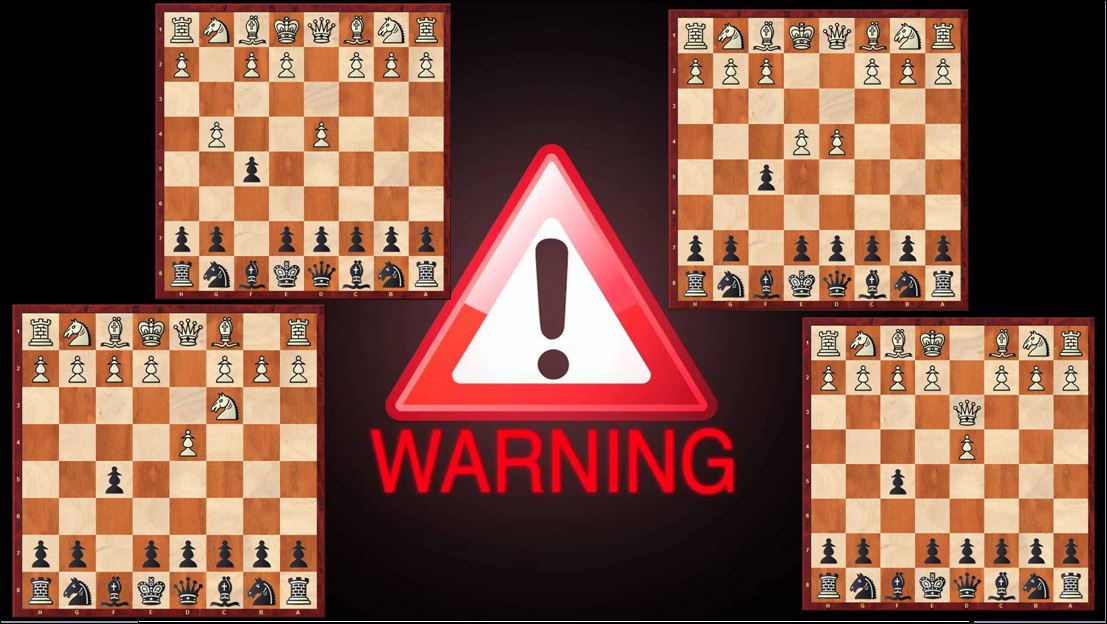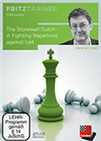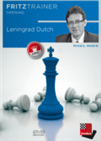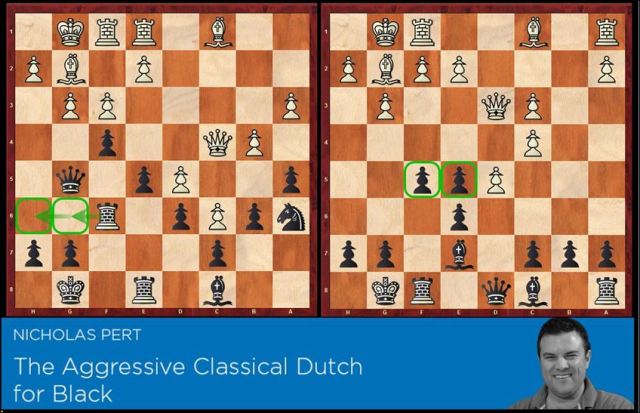A review
The Classical Dutch is a double-edged sword but also a great learning tool to improve our chess. Of course, if we study the openings just to memorise moves, we are wasting time. But if we study an opening like the Classical Dutch to learn the importance of a tempo, or how to create a successful kingside attack, or how to create imbalances on the board, then the study itself becomes an enlightening tool to bring our game to the next level.
I learned to play the Classical Dutch some years ago, inspired by watching some exciting games. After all who doesn't want to launch a lethal kingside attack?
Click or tap a subsequent game in the game list to switch
Obviously, the first criticism which comes to mind is: but those games were played in the 1930s to 50s, when the defensive technique wasn't as good as it is today. Well, then take a look at the following, and notice the names of the losers!
Pert doesn't waste time, and already in the introductory video begins to show some of the lines one will find in the DVD. If after 1.d4 Black plays 1...f5 right away, a player must be ready to face some sidelines, and gambits which can become dangerous. Preparation is key. There is a clear need to watch many games to understand what can go wrong, and avoid disaster in our tournament games.

If unprepared, you may experience nausea on this ride
Here a little sample of possible disasters to warn the fellow chess traveller. Pert covers them in detail in the videos, so no need to worry. But I think for someone who never played the Dutch it can become useful to discover whether this opening is his/her cup of tea, by playing through some games!
1.d4 f5 2.Qd3, I must admit I never faced this move in Blitz or tournament games, but thanks to GM Pert, I discovered it, and found some interesting players who fought against it! Watch the games, paying extra attention to where the pieces should be developed, and in the end, try to discover if one can win from the final position, eventually practising against the ChessBase engine.
We have the Staunton Gambit after the moves: 1.d4 f5 2.e4, and this is definitely a move I have had to combat many times, especially at blitz. It is a dangerous line, and one must really be careful when playing against it. In Megabase I found over 6000 games with it, so a player wanting to play the Dutch should watch at least a hundred of them to be sure to have the main ideas mapped out.
 In the Dutch Stonewall Black from the very first move fights for the initiative. Let Erwin l'Ami take you on a fascinating journey to the depth and attractions of this unique opening. At the end you will be rewarded with a new repertoire against 1.d4!
In the Dutch Stonewall Black from the very first move fights for the initiative. Let Erwin l'Ami take you on a fascinating journey to the depth and attractions of this unique opening. At the end you will be rewarded with a new repertoire against 1.d4!Pert covers all the lines which can come out of the Staunton Gambit including some minor ones like the following: 1.d4 f5 2.e4 fxe4 3.Nc3 Nf6 4.f3 d5 5.fxe4 dxe4 6.Bg5 Bf5 7.Bc4 and here Pert continues the explanation in the video. The diagram below is playable, so the reader can compare the result of the game, with Pert's treatment of this variation:
This is not the end of the line he gives, just an example — one of many — given by Pert. I think it's extremely important to try all of them against an engine.
 On some occasions it would yield you a perfect win, on others it could cause you "shameful" defeats. This DVD is intended in the first line to offer strategical guidance for Black, based on the examination of the most typical structures.
On some occasions it would yield you a perfect win, on others it could cause you "shameful" defeats. This DVD is intended in the first line to offer strategical guidance for Black, based on the examination of the most typical structures.Pert goes one step further, when not teaching moves related to his repertoire, he explains what possible traps Black can fall into, if he doesn't remember the right move and plays something which seems 'natural' like the following: 1.d4 f5 2.e4 fxe4 3.Nc3 Nf6 4.Bg5 and now 4...d5 is a blunder:
This shows Pert is thorough and won't leave the student hanging. Obviously, not everything can be covered but a clear effort was made to give as much as feasible — and 9 hours of video makes this a good value!
1.d4 f5 2.Nc3 and here Pert continues with 2...Nf6 3.Bg5 d5. White has three main options, all covered well. Here a sample of games I found, based on Pert's guidance. Of course, one would be better off listenening to his skilled presentation. Another reason to study the entire series is in relation to move orders — e.g. here's a case where one could enter into the Staunton Gambit.
1.d4 f5 2.Bg5 — Here Pert, who also plays the White side, advises caution with the continuation 2...h6:
Pert also covers setups which today have become mainstream even though they were rares guests in the past. One might be akin to the London System, or the one similar to the Colle.
 On the ABC of the Classical Dutch, IM Andrew Martin gives the student a thorough grounding in the ways of this unconventional opening. The positions that are reached after 1...f5 are always sharp and unclear, suiting the chessboard warrior very well. You cannot play the Dutch with a faint heart! The ABC of the Classical Dutch will analyse systems where predominantly Black plays with an early ...d7-d6. There are discussions of all the key ideas and opening themes, as well as repertoire suggestions for Black.
On the ABC of the Classical Dutch, IM Andrew Martin gives the student a thorough grounding in the ways of this unconventional opening. The positions that are reached after 1...f5 are always sharp and unclear, suiting the chessboard warrior very well. You cannot play the Dutch with a faint heart! The ABC of the Classical Dutch will analyse systems where predominantly Black plays with an early ...d7-d6. There are discussions of all the key ideas and opening themes, as well as repertoire suggestions for Black.For those who don't know the Classical Dutch at all, of course, there are many possible move orders, but in general the opening is defined after the following moves: 1.d4 f5 2.c4 e6 3.g3 Nf6 4.Bg2 Be7 5.Nf3 d6 6.0-0 0-0 — with the move 5...d6 being the main delineator of the Classical Dutch.
The truth is, one could nearly have a full repertoire against White's 1.Nf3, 1.c4 and of course 1.d4, just playing the Dutch.
While I know how to play the Classical Dutch because I've played it a few years ago, I also wanted to refresh it and improve upon my prior knowledge. Every teacher we find on our path will add something to our preparation and eventually close some of the gaps in our theoretical armour. I also know Pert is quite an aggressive player since he plays the French like someone might play the Smith-Morra — to win at all costs, and I wanted to see his interpretation of this opening which is not often seen at the top level.
Pert does a good job pointing out moves one must play in the Dutch in order to be successful. Of course, he also points at the pawn structures we generally aim to achieve, like the following:
 You exchange the bishop on f4 to open the g-file (gxf4) and double rooks there. Black will protect his weakness on this file with all his forces. You transfer your pieces to the other side, create a new weakness there, and the opponent will be helpless
You exchange the bishop on f4 to open the g-file (gxf4) and double rooks there. Black will protect his weakness on this file with all his forces. You transfer your pieces to the other side, create a new weakness there, and the opponent will be helpless
He does a fine job pointing out White's potentially dangerous manoeuvers. I believe one must mix theory with practice — thus my advice to play at least 100 games with the Dutch in addition to watching another 100 games. Many of the themes and motifs explained by Pert will be seen over and over.
I noticed few times Pert mentioned Simon Williams, who is among the biggest experts on the classical Dutch and has a well-known book on the subject. Pert definitely covered all the bases and did the homework for us.
What's in the video series?
It runs for 9 hours! Yes, to have a GM explaining us theory for 9 hours in person would be a dream only for the rich but ChessBase's interactive DVDs provide the next best thing, at a bargain.
You'll find a test section with 14 videos and the DVD comes with three databases: the first database is the theory — 25 games/files which one can update or use as a reference.
Then there is a database with 100 model games. And then the last Database is made up of 92 games based on the games Pert mentioned while teaching opening theory in the videos. It's clearly a comprehensive product, to cover all the needs of the serious tournament player.
Pros and Cons
In every opening, there are bad spots which can be under-estimated by someone who is not familiar with them. In the beginning, in one of the model games, Pert shows an exchange sacrifice, saying Black's compensation is the control of the light squares. Here are the moves for those interested:
1. d4 e6 2.c4 f5 3.g3 Nf6 4.Bg2 Be7 5.Nf3 d6 6.O-O O-O 7.Nc3 Ne4 8.Qc2 Nxc3 9.bxc3 Nc6 10.d5 Na5 11.Qa4 b6 12.dxe6 Bxe6 13.Nd4 Bxc4
Obviously White can follow with 14.Bxa8 gaining the exchange.
Here's another example of a similar continuation, always with Black giving the exchange for light squares, and the e2-weakness:
Now, if someone is not able to play with compensation of this sort, the Classical Dutch may not be for him/her. On the other hand, it would be a mistake to dismiss it, and not try to become proficient in exploiting such compensation. But how?
It's actually quite simple, play it against an engine, at a good level, I generally use Fritz Online — one of the best web apps offered by ChessBase — at Master level.

Obviously, I lose, often getting smashed by Fritz, but then I review the game and take, in this case, the White side. I see how Fritz plays it as Black using the knowledge of how Fritz played it as White. This exercise will give everyone familiarity with the position and leave you well-prepared for your next tournament game.
In this review, you can also use any diagram above as an instant sparring partner. But the general gist of my idea is to play every variation shown by Pert — only in this way will we be prepared for a tournament.
Obviously, the goal of the DVD is to teach the opening rather than middlegame techniques. But sometimes I even disagree with Pert's evaluation, for example after: 1.d4 f5 2.Nf3 Nf6 3.Bg5 e6 4.Nbd2 Be7 5.Bxf6 Bxf6 6.e4 O-O 7.Bd3 d5 8.exf5 exf5 9.O-O Nc6 10.Nb3 Qd6 11.Re1 Bd7 12.c3 b6 13.Qc2 g6 14.Re2 Rae8:
Here Pert's evaluation is: "I feel Black is better here, all Black pieces are active, he's got two bishops, more space on the kingside, it feels as Black is doing well."
I don't disagree on any of the elements he mentioned — they are strictly factual. However, my problem is with the pawn structure. When I see a position as the one above, I ask myself: where did it come from? In this case, we know, but for a moment we could feign ignorance, and answer: "Maybe it's a French exchange!" If that were the case, we know the central file is where everything is exchanged and then we enter an endgame which is generally a draw. Of course, it is better to be on the side with the bishop pair, and space advantage, because if White commits some inaccuracies, then we could also win.
Here is the game from which that line was taken. It was an exciting game!
I think Giri had chances to win and made some move-order mistakes in the middlegame around move 27.
Another point I disagree with the evaluation is the following, based on video n.2 of the test position with Black to move:
Here I thought Black had to defend the c4-pawn, so I played Na5. But in the feedback video, which answered my wrong move, Pert says to find something more tactical.
Then I understood he meant something like 1...Nxd4. But the problem was: I couldn't see the advantage. So after 5-10 minutes, I calculated the following line: 1...Nxd4 2. 2.Bxd4 Ba4 3.Qxa4 Qxd4+ 4.Kh1 Qxd2 5.Qxc4 and I couldn't see a real advantage for Black.
I checked the solution, which gave me the same moves, but I still couldn't understand what was White's advantage. I then gave up, and put the position under the scrutiny of Komodo — and Komodo also agreed with me — the evaluation is a 0.0 equal. So, now what?
Final thoughts
I found this video series immensely useful. The reason is simple: Chess is a very hard sport. I need inspiration and I need to keep my interest up. Pert, with his passionate teaching and abundant ideas, did just that. But the series was also a useful refresher of the theory. To remember something we need to practice it and not all the lines I studied years ago have actually happened in tournament games. Hence it was useful to have a new course which would help me to know the latest theoretical novelties and plans, while reminding me about the lines I never played over the board.
Thanks to the ChessBase tools, I have had the chance to practice some lines and see if I agree with Pert's evaluation. All this work has, as a result, boosted my confidence and understanding. If I may add: one advantage of learning the Dutch is we improve our chess mind's flexibility. For instance, the Classical Dutch teaches us to discern when one should give up an attack on the kingside to begin operations on the queenside.
The Dutch (1.d4 f5) is known as a very aggressive and unbalanced opening, resulting in the lowest percentage of draws among the most common replies to 1.d4 . The opening became popular during the 1951 World Championship match, where both players tried it successfully. Today, players known for spectacular attacking chess are using the opening as a dangerous, surprise weapon.
Links























